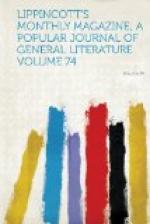And of one-act plays Meilhac and Halevy have written a score or more—delightful little genre pictures, like the Ete de Saint-Martin, simple pastels, like Toto chez Tata, and vigorous caricatures, like the Photographe or the Bresilien. The Frenchman invented the ruffle, says Emerson: the Englishman added the shirt. These little dramatic trifles are French ruffles. In the beginning of his theatrical career M. Meilhac did little comedies like the Sarabande and the Autographe, in the Scribe formula—dramatized anecdotes, but fresher in wit and livelier in fancy than Scribe’s. This early work was far more regular than we find in some of his latest, bright as these are: the Petit Hotel, for instance, and Lolotte are etchings, as it were, instantaneous photographs of certain aspects of life in the city by the Seine or stray paragraphs of the latest news from Paris.
It is perhaps not too much to say that Meilhac and Halevy are seen at their best in these one-act plays. They hit better with a single-barrel than with a revolver. In their five-act plays, whether serious like Fanny Lear or comic like La Vie Parisienne, the interest is scattered, and we have a series of episodes rather than a single story. Just as the egg of the jelly-fish is girt by circles which tighten slowly until the ovoid form is cut into disks of independent life, so if the four intermissions of some of Meilhac and Halevy’s full-sized plays were but a little longer and wider and deeper they would divide the piece into five separate plays, any one of which could fairly hope for success by itself. I have heard that the Roi Candaule was originally an act of La Boule, and the Photographe seems as though it had dropped from La Vie Parisienne by mistake. In M. Meilhac’s earlier five-act plays, the Vertu de Celimene and the Petit fils de Mascarille, there is great power of conception, a real grip on character, but the main action is clogged with tardy incidents, and so the momentum is lost. In these comedies the influence of the new school of Alexandre Dumas fils is plainly visible. And the inclination toward the strong, not to say violent, emotions which Dumas and Angier had imported into comedy is still more evident in Fanny Lear, the first five-act comedy which Meilhac and Halevy wrote together, and which was brought out in 1868. The final situation is one of truth and immense effectiveness, and there is great vigor in the creation of character. The decrepit old rake, the Marquis de Noriolis, feeble in his folly and wandering in helplessness, but irresistible when aroused, is a striking figure; and still more striking is the portrait of his wife, now the Marquise de Noriolis, but once Fanny Lear the adventuress—a woman who has youth, beauty, wealth, everything before her, if it were not for the shame which is behind her: gay and witty, and even good-humored, she is inflexible when she is determined; hers is a velvet manner and an iron will. The name of Fanny Lear may sound familiar to some readers because it was given to an American adventuress in Russia by a grand-ducal admirer.




